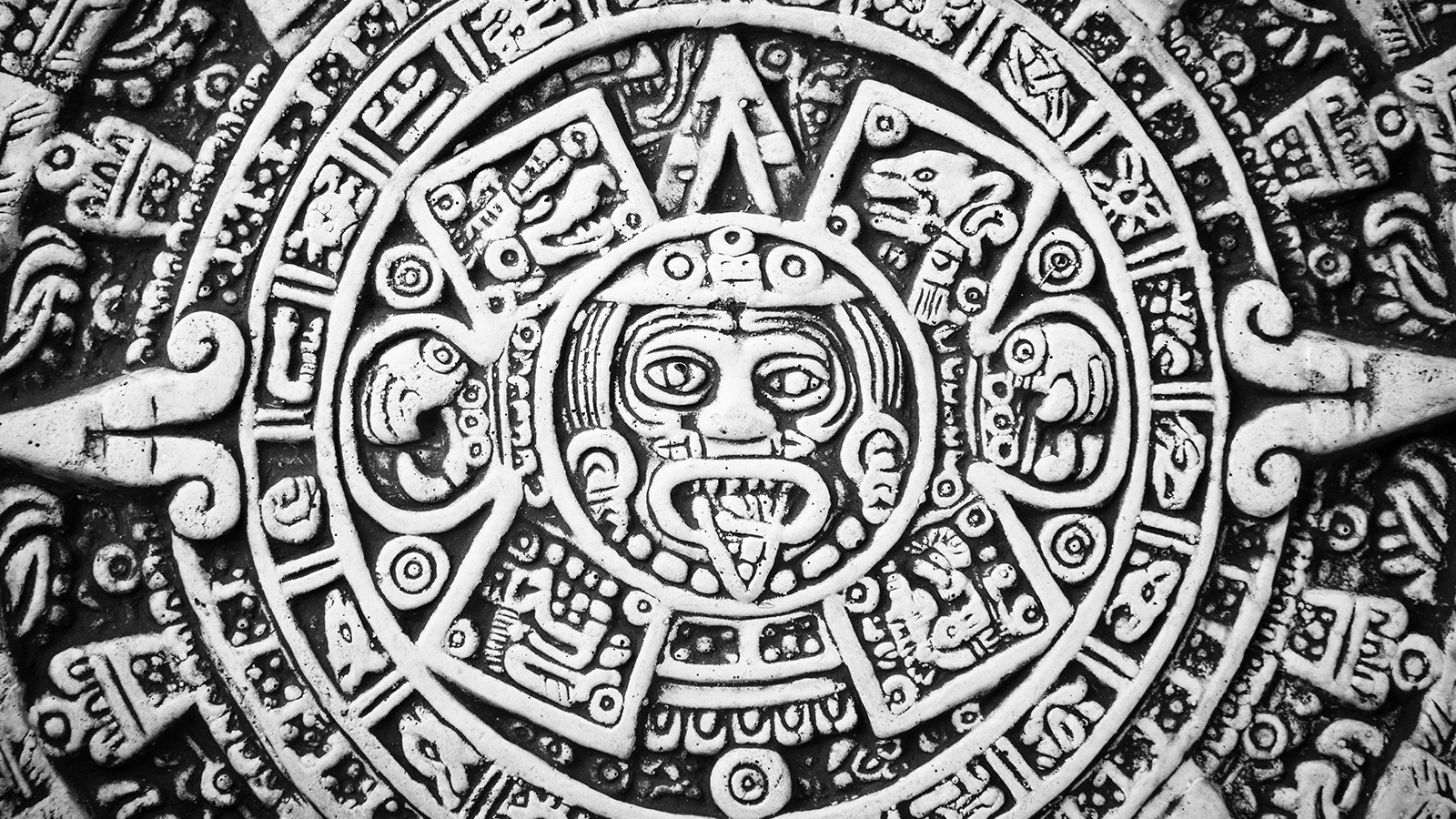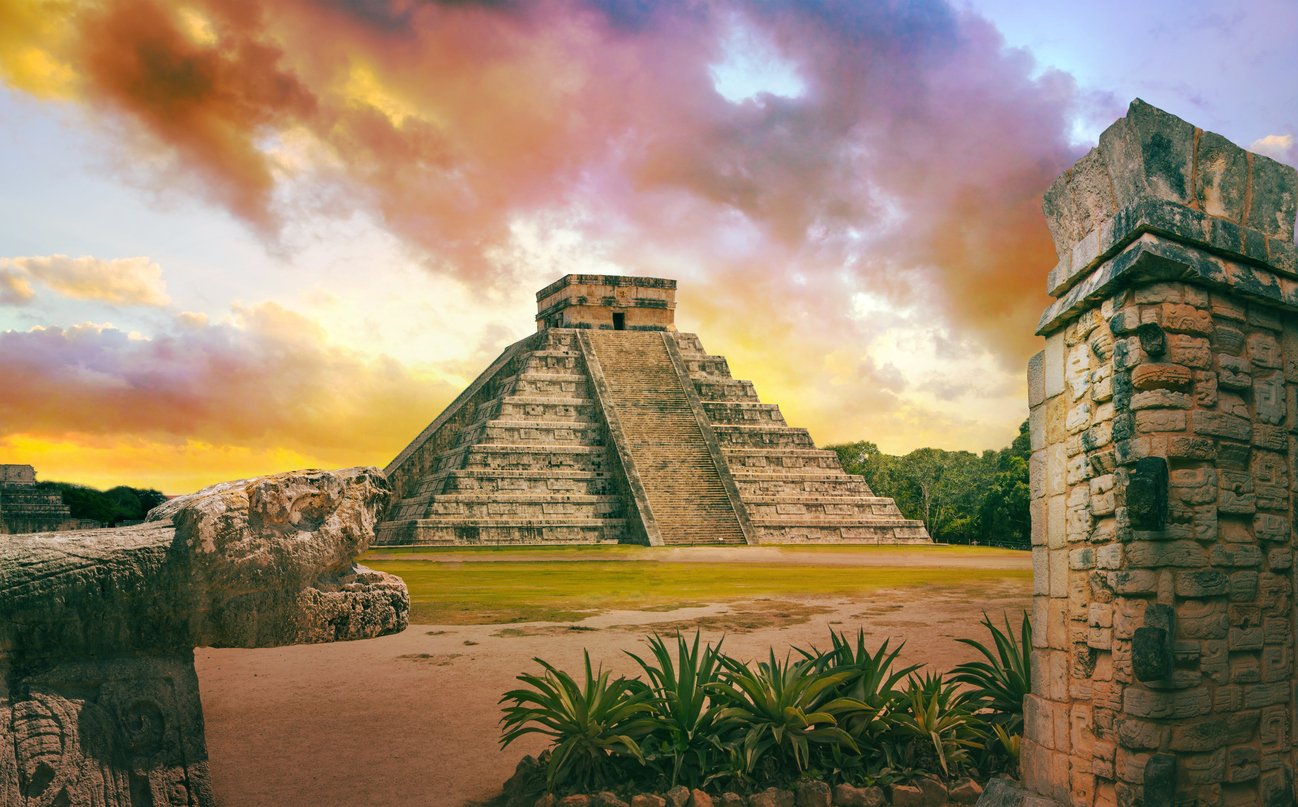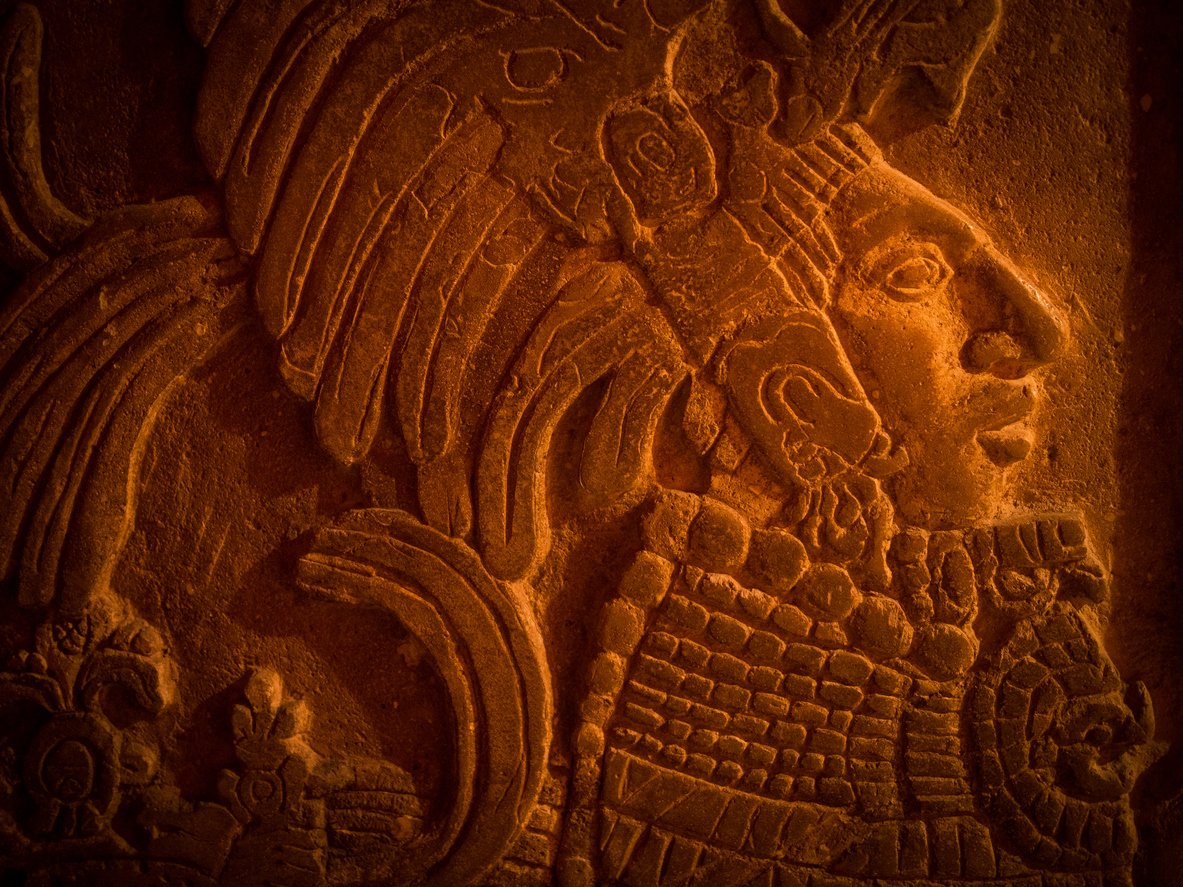
The Maya were one of the most dominant societies in Mesoamerica, settling throughout Honduras, Guatemala, Belize, El Salvador, and the Yucatán. They excelled at astronomy, calendar systems, hieroglyphic writing, and mathematics. They were also skilled farmers, weavers, and potters.
The golden age of the Maya empire began around A.D. 250 and grew to some forty cities. The Maya made paper from tree bark, wrote books, created a ball game, developed the concept of zero, predicted eclipses of the sun and moon, and invented rubberized rain clothing. The study of this civilization would enhance any social studies class.
Chichen Itza
The most famous and largest Mayan city is Chichen Itza, which means “mouth at the well of Itza.” Here you can find the Great Ball Court where Pok-ta-Tok was played. The object of the game was for the two opposing side to try and hit the hard rubber ball into a stone hoop placed at both ends of the playing field. You could only pass or shoot using hips, elbows, knees, or thighs. The teams consisted of two to five players, who tried to keep the ball off the ground. Often, the winners or the losers were sacrificed (or sometimes just the captain of the team). Human sacrifice was important to the Maya people, as they believe it pleased the gods. Have students compare Pok-ta-Tok to similar games, such as soccer and basketball. Ask students: Why was the ballgame so important to the Maya?
The Sacred Cenote, a water-filled sinkhole, is also found at Chichen Itza. The Maya made ceremonial offerings and human sacrifices to the water gods at the cenote. In the Yucatan Peninsula, there are very few lakes or streams. Cenotes provided a stable supply of water. Explain to students how rain absorbs carbon dioxide from the air and forms a weak acid, which trickles down through cracks in limestone to dissolve it over time and form a cenote. Do an experiment with students to demonstrate the effect of rain on limestone by placing drops of lemon juice on a piece of chalk and observing the erosion. Ask students: How did the Maya interact with their environment?

The Pyramid El Castillo at Chichen Itza is the site of the equinox solar phenomena in which a shadow that appears during the equinoxes (representing a serpent) climbs up the pyramid’s steps on March 22 and down them on September 22. Literally, the pyramid is an enlarged, highly magnified solar calendar, in that, if you did the math, you would find that the 91 steps on each side, times 4 for each side and each season, plus 1 for the crowning platform adds up to 365; one step for each day of the solar year. There are 52 panels on the side corresponding to number of years in Mayan calendric cycle, and 18 sections of terraces representing 18-month religious year. The Maya used lines of sight taken from its platforms and door and window jambs to plot the rising and setting positions of the sun, the moon, and the planet Venus.
Introduce the Maya calendar system to students. The Maya calendar used different dating systems in parallel, the Calendar Round, the Long Count, the Tzolkin (divine calendar), and the Haab (civil calendar). The Tzolkin calendar combined a named week of 20 days with a numbered week of 13 days to produce 260 unique days, used to determine the time of religious and ceremonial events. The Haab had 365 days: 18 months, 20 days each month, and 5 unlucky days. Priests decided the unlucky days in which there could be no trips, no crops planted, or marriage. The Calendar Round is made from the interweaving of the Tzolkin and Haab calendars. In the Calendar Round, any given combination of a Tzolkin day with a Haab day will not repeat itself, until 52 periods of 365 days have passed. Many of the Maya believed that the world would end at the close of each of the 52 periods. Any historical or mythical event spanning more than 52 years required the ancient Maya to use an additional calendar, the Long Count. The Long Count represents the number of days since the start of the Maya era. Have students compare the Mayan calendar to the Aztec calendar and the Gregorian calendar. Ask students: How do calendars affect everyday life of humans?

Dzibilchaltun
Dzibilchaltun means “place where there is writing on the stones,” which refers to the use of stelae (carved stone slabs). The Maya commemorated important events on stelae, many times using propaganda to exaggerate the happenings. This city spread over 25 square miles and at its height numbered 40,000 people. The remains of 12 stone roads suggests that Dzibilchaltun may have been the capital of Mayadom. One of the main remaining buildings is the House of the Seven Dolls, given that name because of the offering of seven stone human figures that were found inside. On the spring and fall equinox, the sun shines directly through the doorway. On March 22 and April 20, the moon is seen in the doors. Have students research how Egyptians painted stories on the walls of tombs and Romans sculpted stories on columns, then compare to the Mayan stories on stelae. Ask students: How is social media like stelae?

Uxmal
The most famous of cities in the Puuk (hills) region is Uxmal, which means “thrice built.” Richly ornamented mosaic stonework and the more than 200 stone masks of Chac (hook-nosed rain god) helped make this a designated UNESCO World Heritage Site. Each eyelid on Chac is carved with glyph representing Venus, and the House of Governors faces a horizon spot where Venus would have risen as the morning star. The Nunnery Quadrangle is a group of four separate rectangular buildings arranged around an interior court. The North Building has 13 doorways to represent the 13 layers of heaven; the West Building has seven doorways to represent Middleworld (the place of sun’s descent to Underworld), the East Building has five doorways to represent Middleworld (the place of rising sun), and the South Building has nine exterior doorways to represent the nine layers of the Underworld. The Maya believed each level of the cosmos had four cardinal directions associated with a different color: white for north, red for east, yellow for south, and black for west. Have students research information on Middleworld and compare to Middle Earth. Ask students: What are some other names and descriptions for Underworld in different cultures?
By A.D. 900, most of the Mayan societies had collapsed. Some historians believe that overpopulation, overuse of the land, warfare, and drought may have played a part in the downfall. Mayans still exist today, still maintain agriculture and trade, participate in traditional rituals, and use the Mayan calendar. About 40% of Guatemalans are of Mayan descent. As Rigoberta Menchu, winner of the 1992 Nobel Peace Prize, opines: “We are not myths in the past, ruins in the jungle, or zoos. We are people and we want to be respected, not to be victims of tolerance and racism.”
Engage students with a simulation activity of the Mayan culture
Learn how with our Interact series
Kay Gandy is a retired professor of seventeen years and a retired elementary teacher of twenty-seven years. Her goal is to work with teachers in countries around the world and watch movies in foreign theaters. Her books Mapping Is Elementary, My Dear and 50 Ways to Teach Social Studies provide practical lesson ideas for elementary teachers.
